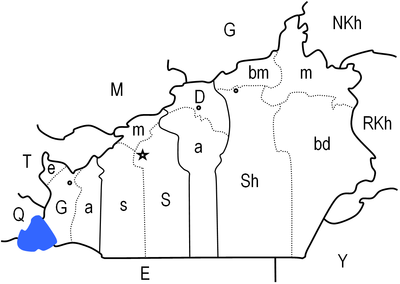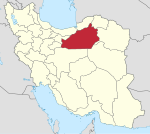Semnan province
Semnan Province
استان سمنان | |
|---|---|
 | |
 Location of Semnān within Iran | |
| Country | |
| Region | Region 1 [1] |
| Capital | Semnan |
| Counties | 8 |
| Government | |
| • Governor | Mohammad Reza Khabbaz |
| Area | |
| • Total | 97,491 km2 (37,641 sq mi) |
| Population (2011)[2] | |
| • Total | 631,218 |
| • Density | 6.5/km2 (17/sq mi) |
| Time zone | UTC+03:30 (IRST) |
| • Summer (DST) | UTC+04:30 (IRST) |
| Main language(s) | Semnani languages, Persian |
Semnan Province (Persian: استان سمنان, Ostān-e Semnān ) is one of the 31 provinces of Iran. It is in the north of the country, and its center is Semnan. The province of Semnan covers an area of 96,816 square kilometers and stretches along the Alborz mountain range and borders to Dasht-e Kavir desert in its southern parts.
The province was put as part of Region 1 upon the division of the provinces into 5 regions solely for coordination and development purposes on June 22, 2014.[1]
Counties of the province include Semnan, Aradan, Damghan, Shahrud, Mehdishahr, Meyami, Sorkheh, Garmsar, and Shahmirzad county. In 1996, the province had a population of about 501,000 (631,218 in 2011 [2]), and in 2005 Semnan city (the capital of the province) had a population of 119,778, and the city of Shahroud, which accounts for being the largest city of this province, had a population of 231,831. [1]
Geography
The province is divided into two parts: a mountainous region, and the plains at the foot of the mountains. The former offers a scope for recreational activities as well as being a source for minerals, whereas the latter encompasses some ancient cities of Iran as one of the capitals of the Parthian empire was located there. In Semnan, people have local language with special words and slang. the base of this language which it derived from is Pahlavi language the ancient language form Parthian.
Neighbours are in the north Golestan, Mazandaran, at the west Tehran, Qom, at the South Isfahan and at the East Khorasan-e Razavi.
Abr forest
This forest lies in the central province of Semnan, near its border with Golestan Province. It is one of the oldest forests in Iran which is a remnant of the third geological age. The Iranian Roads Ministry's decision to build a road through the forest sparked widespread protests last year.[when?]
The environmentalists, backed by the country's media, began a wide campaign against the ministry's decision, which finally led the Prosecutor General to order a halt in the construction of the road. However, all these efforts came to naught when it was announced in April 2008 that the government granted permission to the Roads Ministry to construct the road.[citation needed]
Administrative divisions
This section's factual accuracy may be compromised due to out-of-date information. (May 2013) |
| Map | Shahrestan | Map Key | Bakhsh | Center |
|---|---|---|---|---|

| ||||
| Damghan | D | Central | Damghan | |
| a | Amir Abad | |||
| Garmsar | G | Central | Garmsar | |
| a | Aradan | |||
| e | Eyvanakey | |||
| Mehdishahr | m | Central | Mehdishahr | |
| ' | Shahmirzad | |||
| Semnan | S | Central | Semnan | |
| s | Sorkheh | |||
| Shahrud | Sh | Central | Shahrud | |
| bd | Biarjmand | |||
| bm | Mayami | |||
| m | Bastam | |||
| Neighbor Provinces: E: Esfahan, G: Golestan, M: Mazandaran, NKh: North Khorasan, Q: Qom, RKh: Razavi Khorasan, T: Tehran, Y: Yazd | ||||
History
Semnan can be divided into sixteen sectors from the old days of Avesta. During the Medes and Achaemenid periods, it accounted for being one of the largest provinces of the empire, and today it roughly corresponds to the borders of the ancient region of Parthia.
During the Islamic era, Semnan was part of the historical region of Gomess or Komesh, and the Silk Road paved its way from the midst of this region. Needless to say, the province was witness to numerous wars.
The Cultural Historical Heritage Organization of Iran lists 470 sites of historical and cultural heritage such as palaces, forts, castles, caravansarais, ab anbars, and badgirs, in Semnan. In addition to these there are various religious and sacred places as well.
Orbital launch site
On occasion of the 10th anniversary of the 1998 Kwangmyongsong 1 satellite launch attempt, program conducted by North Korea in close cooperation with Iran and Pakistan, the Iranian Space Agency has proceeded with its own test. According to practice also observed by North Korea, Iranian authorities announced to their Chinese allies on August 16, 2008 the imminent launch of a satellite.[3] On August 17, 2008 on the occasion of the birthday anniversary of Shiites' 12th Imam Hazrat Mahdi, Iran proceeded as preannounced with the second test launch of a three stages Safir SLV from a site 35°14′5″N 53°55′15″E / 35.23472°N 53.92083°E south of Semnan in the northern part of the Dasht-e-Kavir desert. Reza Taghizadeh, head of the Iranian Aerospace Organization, told state television "The Safir (Ambassador) satellite carrier was launched today and for the first time we successfully launched a dummy satellite into orbit".[4] As reported in late 2009 and early 2010, a new, larger launch pad was under construction at 35°15′30″N 53°57′17″E / 35.25833°N 53.95472°E[5][6]
See also
- Bayazid Bastami
- Darius III
- Dasht-e Kavir
- Fath Ali Shah Qajar
- Hassan Rouhani
- Hecatompylos or Shahr-e Qumis
- Mahmud Ahmadinejad
- Manuchehri Damghani
- Parthia
- Rig-e Jenn
- Sangsar (Mahdishahr)
- Seleucids
- Semnani language
- Yadollah Royaee
References
- ^ a b همشهری آنلاین-استانهای کشور به ۵ منطقه تقسیم شدند
- ^ a b Selected findings of National Population and Housing Census 2011 Archived May 31, 2013, at the Wayback Machine
- ^ "伊朗将于下周发射自主生产的卫星". 伊通社. 2008-08-16. Retrieved August 18, 2008.
- ^ "Iran says it has put first dummy satellite in orbit". Reuters. Retrieved 2008-08-18.
{{cite web}}: Italic or bold markup not allowed in:|publisher=(help) [dead link] - ^ Massive Construction Visible at Iran's Missile & Space Center at Semnan
- ^ Imagery of Construction of New Launch Site in Iran
External links
- History of Semnan Province
- Information on Semnan National geoscience database of Iran
- Semnan Cultual Heritage Organization
- SemnanLine NEWSPORTAL
- Chisholm, Hugh, ed. (1911). . Encyclopædia Britannica (11th ed.). Cambridge University Press.

